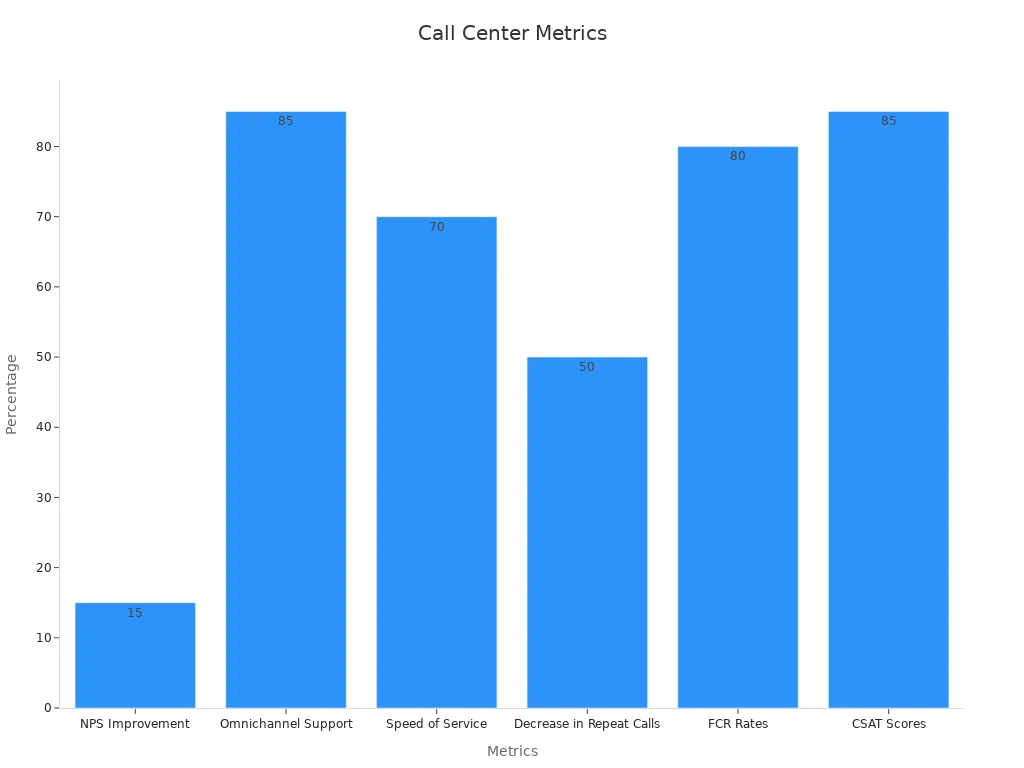Understanding CSAT Scores and Their Role in Customer Service

Customer Satisfaction Score (CSAT) measures how happy customers feel after interacting with a business. It serves as a direct indicator of customer sentiment, helping you gauge the quality of your service. High CSAT scores often reflect excellent customer service, which fosters loyalty and reduces churn. Studies show that even a 10% rise in CSAT can cut churn rates by up to 12%. Companies like Airbnb have seen repeat bookings and referrals soar by prioritizing satisfaction. Sobot's customer-centric solutions empower businesses to track and improve CSAT score meaning, driving long-term growth and retention.
What Is the CSAT Score Meaning in Customer Service?
Definition and Purpose of CSAT Scores
CSAT scores measure how satisfied your customers feel after interacting with your business. This metric is typically calculated through a simple survey question asking customers to rate their satisfaction with a product or service. The results are expressed as a percentage, representing the proportion of satisfied customers. For example, if 80 out of 100 respondents rate their experience positively, your CSAT score would be 80%.
The purpose of CSAT scores goes beyond just numbers. They help you understand customer sentiment and identify areas where your service can improve. By tracking these scores over time, you can evaluate the effectiveness of your strategies and make data-driven decisions to enhance customer satisfaction. Businesses often use CSAT to build stronger relationships with disengaged customers by addressing their feedback promptly.
Tip: A high CSAT score often correlates with customer loyalty and retention, which can positively impact your revenue.
How CSAT Scores Reflect Customer Sentiment
CSAT scores provide a direct reflection of how your customers feel about their experiences. When customers rate their satisfaction, they give you valuable insights into what works and what doesn’t. For instance, a low score might indicate issues like long wait times or unhelpful support, while a high score shows that your service meets or exceeds expectations.
To illustrate, consider the following data:
| Metric | Value Before | Value After | Industry Average |
|---|---|---|---|
| CSAT Score | 62 | 82 | 78 |
This table shows how improving service quality can significantly boost CSAT scores. A jump from 62 to 82 not only surpasses the industry average but also highlights the effectiveness of addressing customer concerns. Tracking these changes helps you understand how your efforts impact customer sentiment over time.
Common Applications of CSAT Scores in Customer Support
CSAT scores play a vital role in customer support by helping you measure and improve the quality of your service. Here are some common ways businesses use CSAT scores:
- Evaluating Customer Experience: CSAT surveys allow you to gauge how satisfied customers are with specific interactions, such as resolving a support ticket or completing a purchase.
- Identifying Pain Points: By analyzing low scores, you can pinpoint areas where your service falls short and take corrective action.
- Comparing Performance Across Channels: CSAT scores help you compare satisfaction levels across different communication channels, such as email, live chat, and phone support.
- Tracking Progress Over Time: Monitoring CSAT trends enables you to assess the long-term impact of your customer service strategies.
For example, in the healthcare industry, reported CSAT scores typically range from 79% to 86%. Achieving a score within this range indicates that your service meets industry standards, while exceeding it shows exceptional performance.
Note: CSAT surveys are most effective when they include clear, concise questions and are distributed immediately after a customer interaction.
How Are CSAT Scores Calculated?
Standard Formula for CSAT Calculation
Calculating CSAT scores is straightforward and relies on customer feedback collected through surveys. The formula involves three simple steps:
- Count the number of positive responses (e.g., ratings of 4 or 5 on a 5-point scale).
- Divide this number by the total number of survey respondents.
- Multiply the result by 100 to express the score as a percentage.
For example, if 80 out of 100 customers rate their experience positively, your CSAT score would be 80%. This method ensures accuracy and reliability by focusing on the most satisfied customers.
| Aspect | Description |
|---|---|
| Measurement | CSAT is measured on a scale (e.g., 1 to 5 or 1 to 10) where customers rate their satisfaction. |
| Formula | CSAT = (Number of Positive Responses / Total Number of Respondents) x 100 |
| Validation | Regular feedback collection and benchmarking against industry standards validate the reliability of the CSAT. |
By consistently applying this formula, you can track satisfaction trends and benchmark your performance against competitors.
Examples of Effective CSAT Survey Questions
Crafting the right survey questions is essential for capturing accurate customer sentiment. Here are some examples:
- "How satisfied were you with the speed of our service?"
- "On a scale of 1 to 5, how easy was it to navigate our website?"
- "How likely are you to recommend our customer support to others?"
To maximize the effectiveness of your surveys:
- Start with an overall satisfaction question to identify trends.
- Include detailed attribute-based questions for diagnostic insights.
- Allow open-text feedback to uncover hidden issues.
- Keep questions short and relevant to avoid survey fatigue.
Timing also matters. Sending surveys immediately after a customer interaction ensures accurate and actionable responses.
Tools for Measuring CSAT Scores, Including Sobot's Voice/Call Center

Advanced tools simplify the process of measuring CSAT scores. Sobot's Voice/Call Center, for instance, offers features that enhance CSAT tracking and analysis. With AI-powered voicebots, real-time call monitoring, and data analytics, you can gather and evaluate customer feedback efficiently.
| Statistic | Description |
|---|---|
| NPS Improvement | Call centers using AI tools report NPS that are 15% higher. |
| Speed of Service | 70% of customers say service speed impacts their brand perception. |
| CSAT Scores | Well-run call centers maintain CSAT scores around 85%. |
| AI Application | Sobot’s Voice/Call Center uses AI to enhance operational efficiency. |

Sobot's platform also integrates seamlessly with your existing systems, ensuring a unified workspace for agents. This makes it easier to track CSAT scores across multiple channels and improve customer satisfaction.
Why CSAT Scores Matter for Customer Satisfaction

Benefits of Tracking CSAT Scores
Tracking CSAT scores offers several advantages that directly impact your service quality and customer satisfaction. By consistently measuring these scores, you gain actionable insights into what works and what needs improvement. For example:
- Short and clear surveys show customers that their opinions matter, fostering trust.
- Follow-up questions after a CSAT rating help you identify areas where your team excels or struggles.
- Empowering agents with direct access to feedback allows them to adjust their approach and improve interactions.
- Alerts for low scores enable immediate coaching, ensuring service recovery in real time.
Regularly monitoring CSAT scores also helps you spot bottlenecks in your processes. Addressing these issues promptly can reduce customer churn and improve retention rates. High CSAT scores often indicate that your service meets or exceeds expectations, which strengthens customer loyalty.
Identifying Pain Points in Customer Service
CSAT scores act as a magnifying glass, helping you uncover critical pain points in your customer service processes. Low scores often highlight areas where customers face challenges, such as long wait times or unclear communication. Collecting feedback at key touchpoints in the customer journey provides valuable data for targeted improvements.
| Evidence Description | Key Insight |
|---|---|
| Regular CSAT measurement provides insights into customer preferences and struggles. | Helps identify specific products, pages, or processes that need improvement. |
| Low CSAT scores indicate potential issues in various areas. | Quick identification of pain points allows for targeted improvements to enhance customer experience. |
| Collecting CSAT feedback at key touchpoints is crucial. | Enables data-driven decisions at critical moments in the customer journey. |
By addressing these pain points, you can create a smoother and more satisfying experience for your customers. This proactive approach not only improves service quality but also builds trust and loyalty.
Enhancing Retention and Loyalty Through CSAT Insights
CSAT insights play a pivotal role in boosting customer retention and loyalty. High satisfaction levels often correlate with reduced churn rates, as satisfied customers are more likely to stay with your brand. Tracking CSAT scores consistently reveals patterns that help you align your strategies with customer needs.
| Evidence | Description |
|---|---|
| CSAT Insights | Leveraging CSAT insights can greatly enhance customer experience and benchmarking these scores provides an opportunity to measure performance against industry standards. High CSAT scores indicate strong customer loyalty, a critical asset for any business. |
| Tracking CSAT | Organizations that routinely track CSAT can identify areas for improvement, pivoting strategies to address customer pain points effectively. This analysis provides a clearer picture of customer sentiments and aligns team objectives with retention-driven QA metrics. |
| Patterns in CSAT | Tracking CSAT scores consistently reveals patterns that impact customer retention. High satisfaction levels often correlate with customer loyalty and reduced churn rates, promoting a customer-centric culture that enhances retention. |
By leveraging these insights, you can refine your service strategies and foster long-term relationships with your customers. A focus on CSAT not only enhances retention but also creates a loyal customer base that advocates for your brand.
Best Practices for Using CSAT Scores Effectively
Designing a Customer Satisfaction Survey That Works
Creating an effective customer satisfaction survey requires thoughtful design. A well-structured survey captures accurate customer feedback and provides actionable insights. Start by setting clear objectives. Define what you aim to learn, whether it’s satisfaction with a specific service or overall client satisfaction. This focus ensures your questions align with your goals.
Introduce the survey with a brief explanation of its purpose and duration. This helps respondents understand its importance and encourages participation. Include relevant questions that avoid bias and focus on specific aspects of the customer experience. For example, ask, “How satisfied were you with the resolution of your issue?” instead of vague questions like, “Was the service good?”
Use a mix of closed-ended and open-ended questions. Closed-ended questions provide measurable data, while open-ended ones uncover deeper insights. Keep the survey concise to prevent fatigue. A short survey with three to five questions often yields higher response rates.
Tip: Add a clear call to action, such as “Click here to share your thoughts,” to make the survey link prominent and accessible.
Timing and Distribution of CSAT Surveys
The timing and distribution of CSAT surveys significantly impact response rates and data quality. Research shows that weekdays, particularly Tuesday through Friday mornings, are optimal for sending surveys. Avoid weekends to respect customers’ leisure time. For B2B audiences, mornings before noon or late afternoons between 3 PM and 6 PM work best.
Distribute surveys immediately after key interactions, such as resolving a support ticket or completing a purchase. This ensures feedback reflects the most recent experience. For ongoing relationships, send CSAT surveys after major product updates, renewals, or every 6-12 months to track long-term satisfaction trends.
Short surveys perform better on Tuesdays, while longer ones are more effective on Wednesdays or Fridays. Timing emails between 1 and 4 a.m. increases visibility in inboxes, as they appear at the top when customers check their emails.
| Timing Recommendation | Details |
|---|---|
| Best Days for Surveys | Tuesday, Wednesday, Thursday, and Friday mornings |
| Ideal Time for B2B | Mornings before noon or between 3 PM and 6 PM |
| Survey Frequency | After interactions, renewals, updates, and regular follow-ups every 6-12 months |
| Avoid Weekends | Respect customers’ leisure time |
| Short vs Long Surveys | Short surveys on Tuesdays; longer surveys on Wednesdays or Fridays |
Note: Timing your surveys strategically improves engagement and ensures you collect meaningful feedback.
Analyzing Feedback for Actionable Insights
Analyzing CSAT feedback transforms raw data into actionable insights. Start by categorizing responses to identify trends. Positive feedback highlights areas of strength, while negative feedback pinpoints pain points. For example, ParkBee analyzed CSAT feedback after parking sessions and reduced customer service contact rates by 20%.
Use contextual feedback to understand the “why” behind the scores. Taxfix personalized user journeys through targeted surveys, achieving an NPS of 68, which reflects high customer loyalty. Similarly, Workwise gathered in-product feedback to make data-driven decisions that enhanced user satisfaction.
| Company | Action Taken | Result |
|---|---|---|
| ParkBee | Analyzed CSAT feedback after parking sessions | 20% reduction in customer service contact rate |
| Taxfix | Personalized user journeys through surveys | NPS of 68, indicating high customer loyalty |
| Workwise | Gathered contextual feedback via surveys | Enhanced user satisfaction |
| Hitta | Continuously tracked satisfaction metrics | Improved engagement and maintained high satisfaction levels |
Regularly tracking metrics like CSAT scores helps you measure the impact of changes. Use these insights to refine your strategies and align them with customer needs. Implementing a customer-centric approach builds stronger relationships and drives retention.
Tip: The real value of CSAT analysis lies in taking action. Address pain points promptly to improve service quality and customer satisfaction.
Implementing Changes Based on CSAT Data
Acting on CSAT survey results is essential for improving customer satisfaction and service quality. When you collect feedback, it’s not just about gathering data; it’s about using that data to drive meaningful changes. Here’s how you can effectively implement changes based on CSAT data:
- Create a Feedback Ecosystem: Use multiple methods to collect feedback, such as post-interaction surveys, email follow-ups, and in-app prompts. Real-time alerts for negative feedback allow you to address issues immediately, showing customers that their opinions matter.
- Balance Autonomy and Guidelines: Empower your agents to solve problems creatively while providing clear guidelines. This balance ensures personalized solutions without compromising consistency.
- Compare and Benchmark: Regularly compare your current CSAT scores with original benchmarks. This helps you assess whether your changes are effective and identify areas for further improvement.
- Visualize Trends: Develop a customer satisfaction dashboard to track changes and trends. Visual tools make it easier to spot patterns and share insights with your team.
- Document and Replicate Success: Record the changes you implement and their outcomes. This documentation helps you replicate successful strategies or refine those that fall short.
For example, companies that act on customer feedback often see significant improvements in their CSAT scores. By addressing pain points highlighted in surveys, you can enhance the overall customer experience and build stronger relationships. Sobot’s Voice/Call Center can assist in this process by providing real-time analytics and monitoring tools, enabling you to track the impact of your changes effectively.
Tip: Always communicate the changes you’ve made to your customers. This transparency builds trust and shows that you value their input.
Regularly Monitoring and Updating CSAT Strategies
Customer expectations evolve, and so should your CSAT strategies. Regular monitoring and updates ensure your approach remains relevant and effective. Here’s why this practice is crucial and how you can do it:
- Stay Aligned with Customer Needs: Updating your strategy demonstrates your commitment to meeting customer expectations. This fosters positive interactions and encourages brand advocacy.
- Boost Retention and Loyalty: An adaptive approach builds trust, making customers more likely to stay with your brand. For instance, businesses that update their strategies based on feedback often see higher retention rates.
- Enhance Brand Reputation: A responsive strategy reflects your brand’s values. Customers notice when you actively listen and improve, which strengthens your reputation.
- Integrate the Latest Tools: Regular updates allow you to incorporate new technologies, such as AI-powered analytics or omnichannel solutions like Sobot’s platform. These tools streamline processes and improve efficiency.
- Ensure Consistency Across Channels: An updated strategy creates a seamless customer journey, whether they interact with you via phone, email, or live chat.
To monitor effectively, track CSAT scores across all touchpoints and analyze trends over time. Use tools like Sobot’s unified workspace to consolidate data from multiple channels. This approach ensures you have a comprehensive view of customer sentiment. Additionally, schedule periodic reviews of your strategy to identify gaps and opportunities for improvement.
Note: Regular updates to your CSAT strategy not only improve customer satisfaction but also position your business as an industry leader.
Leveraging CSAT Scores to Improve Customer Satisfaction

Aligning CSAT Insights with Business Goals
CSAT insights can serve as a powerful tool to align your customer service strategies with broader business objectives. By analyzing CSAT data, you can identify specific pain points in the customer journey and prioritize improvements that directly impact client satisfaction. For example, Hilton Hotels uses CSAT as a key performance indicator to enhance guest experiences, while Bank of America aligns its customer experience strategies with metrics that drive loyalty.
To make the most of CSAT insights, focus on connecting them to measurable business outcomes. For instance, companies with above-average CSAT scores often report higher customer retention rates and increased word-of-mouth referrals. Understanding how CSAT relates to other performance metrics, such as response time or average handle time, allows you to predict and improve satisfaction levels. This approach ensures that your efforts not only enhance customer satisfaction but also contribute to long-term business success.
Training Customer Service Teams Using CSAT Data
CSAT data provides valuable insights into your team’s performance, helping you identify areas for improvement. Negative feedback often highlights specific knowledge gaps or skill deficiencies. By analyzing these trends, you can design targeted training programs to address these issues. For example, if low scores frequently mention slow response times, you can train your team to improve first response time, which directly impacts customer satisfaction.
Communicating CSAT goals to your team ensures everyone understands their role in achieving high satisfaction levels. Regularly sharing feedback with your staff fosters a culture of continuous improvement. For instance, when T-Mobile analyzed CSAT data, they refined their service offerings and improved customer retention. By linking CSAT insights to training, you empower your team to deliver better service and create more positive customer experiences.
Personalizing Customer Experiences Based on Feedback
Personalization has become a cornerstone of exceptional customer service. CSAT surveys provide actionable insights that help you tailor interactions to meet individual needs. For example, real-time feedback from surveys allows you to act quickly on customer concerns, addressing issues before they escalate. Studies show that 64% of customers expect instant assistance, making timely responses crucial.
Tailored experiences not only enhance satisfaction but also build loyalty. By analyzing CSAT data, you can identify trends and preferences, enabling you to offer personalized solutions. For instance, if customers frequently praise a specific feature, you can highlight it in your marketing efforts. Personalization demonstrates that you value your customers’ opinions, fostering trust and long-term relationships.
Tip: Use tools like Sobot’s Voice/Call Center to gather and analyze CSAT data efficiently. Features like real-time monitoring and AI-powered analytics make it easier to deliver personalized, high-quality service.
How Sobot's Voice/Call Center Enhances CSAT Tracking and Analysis
Sobot's Voice/Call Center offers advanced tools that simplify CSAT tracking and analysis. Its features enable you to collect, monitor, and interpret customer feedback efficiently. By leveraging AI-powered voicebots and real-time analytics, you gain deeper insights into customer satisfaction levels. These tools help you identify trends and make informed decisions to improve service quality.
The platform excels in delivering accurate data. For example, it achieves a customer satisfaction rate of over 95% and a CSAT score of 97%. Its intelligent systems resolve 22.2% of self-service questions, reducing the workload on agents. Additionally, the problem resolution rate reaches 85%, ensuring most issues are addressed effectively.
| Metric | Value |
|---|---|
| Correct Answers | Over 80% |
| Customer Satisfaction Rate | Over 95% |
| Self-Service Question Resolution | 22.2% |
| CSAT Score | 97% |
| Problem Resolution Rate | 85% |
| Customer Happiness Rate | 99% |
Sobot's unified workspace integrates customer data from multiple channels, allowing agents to access detailed information during calls. This feature enhances personalization and boosts customer happiness rates to 99%. The platform also supports global telephony, ensuring seamless communication across regions.
By using Sobot's Voice/Call Center, you can track CSAT scores across various touchpoints and improve customer satisfaction consistently. Its robust analytics tools provide actionable insights, helping you refine your strategies and deliver exceptional service.
Tip: Regularly monitor CSAT trends using Sobot's real-time dashboards to stay ahead of customer expectations.
CSAT scores play a vital role in improving customer satisfaction and driving business success. They provide immediate feedback on customer happiness, helping you identify and resolve issues quickly. Happy customers often return for future purchases and recommend your services to others.
- Regularly tracking CSAT alongside other metrics enhances customer experiences.
- Implementing actionable insights fosters loyalty and retention.
Sobot’s Voice/Call Center simplifies CSAT tracking with AI-powered tools and real-time analytics. By leveraging these solutions, you can refine your strategies and deliver exceptional service. Explore how Sobot can transform your customer service approach here.
FAQ
What is a good CSAT score?
A good CSAT score typically ranges from 75% to 85%. This indicates that most customers are satisfied with your service. However, aiming for higher scores can further enhance customer loyalty and retention.
How often should you measure CSAT scores?
You should measure CSAT scores regularly, ideally after key customer interactions. This includes after purchases, support calls, or service completions. Frequent measurement helps you track satisfaction trends and make timely improvements.
Can CSAT scores predict customer loyalty?
Yes, CSAT scores can predict customer loyalty. High scores often correlate with repeat business and positive word-of-mouth. By maintaining high satisfaction levels, you increase the likelihood of customers returning and recommending your services.
How do CSAT scores differ from NPS?
CSAT scores measure immediate satisfaction after specific interactions. NPS (Net Promoter Score) gauges overall customer loyalty and likelihood to recommend your brand. Both metrics provide valuable insights but focus on different aspects of customer experience.
Why is it important to act on CSAT feedback?
Acting on CSAT feedback shows customers you value their opinions. It helps you address pain points and improve service quality. This proactive approach enhances customer satisfaction and fosters long-term loyalty.
See Also
Exploring The Responsibilities Of IT Call Center Agents
Navigating Quality Management Systems In Call Centers
Top Strategies For Quality Management In Call Centers
Enhancing Efficiency With AI-Driven Customer Service Solutions
